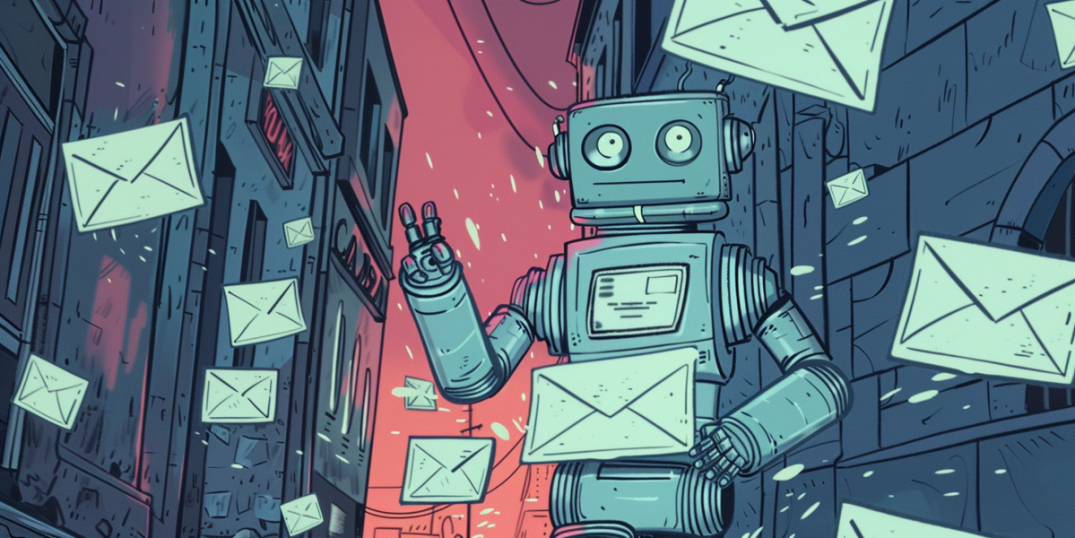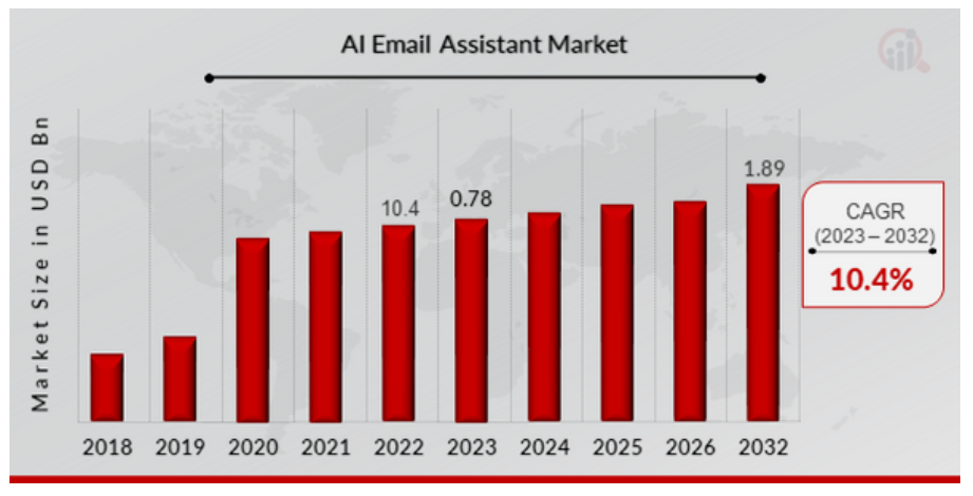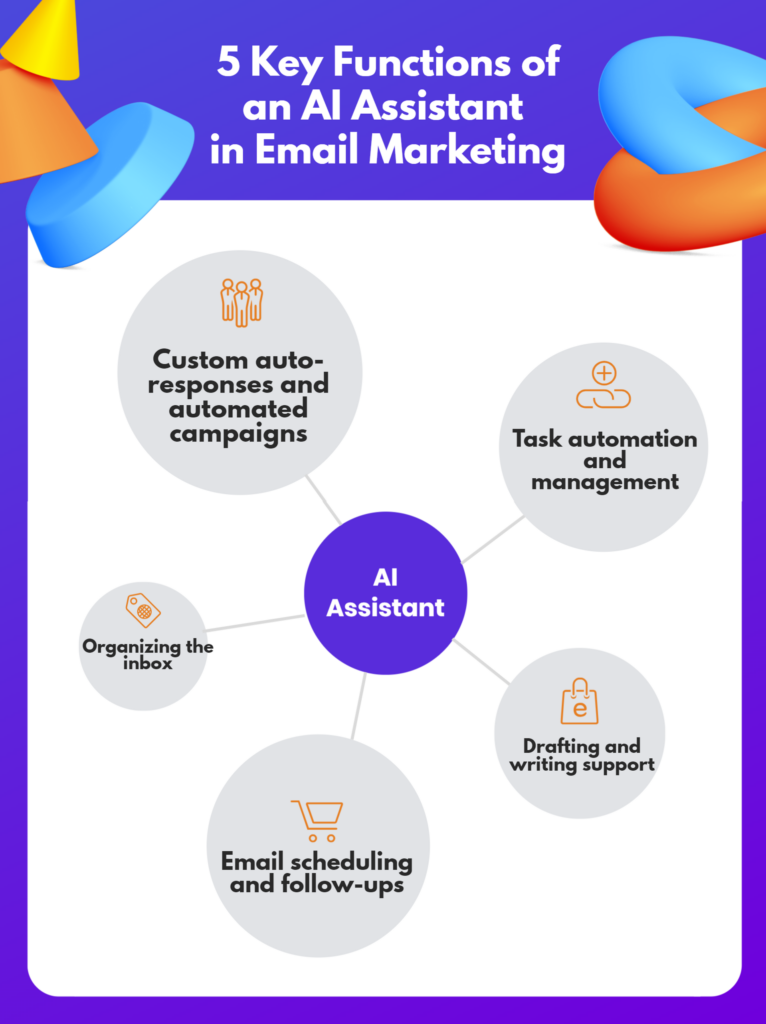- Home
- Fundamentals of Email Marketing
- How AI Email Assistants Make Y ...

The management of our mailboxes can be compared to optimizing space in a wardrobe—the better system you have for allocating and clustering things (mail), the lower the chances of your space being cluttered. But what if there was a tool that would not only advise you on some of the best ways to manage your stuff but also do it with you and even for you? We do not know about the existence of such tools for wardrobes, but there are some good ones for mailboxes.
These tools have a wide range of ways for optimizing work with emails and are fitting for a wide range of professionals across different industries. In 2024, around 46% of all companies in the United States used AI in their activities, while a year before, 75% of respondents were using AI for tasks like writing emails. This popularity of AI for email optimization explains the predictive growth of the market: from $0.78 billion in 2023 to $1.89 billion by 2032.

This data looks impressive, and we decided to take a closer look at the functionality of AI email assistants and see what makes them so appealing. Keep on reading to learn about the advantages of those tools, their use cases, and some of the particular examples of AI email assistants.
What Is an AI Email Assistant?
An AI email assistant is a software tool that leverages artificial intelligence to boost email management. How does it do that? It utilizes machine learning algorithms and natural language processing to understand the context of emails, generate human-like responses, and automate routine tasks. In other words, it does all the work that we usually hate for keeping your email organized and productive.
An AI email assistant allows you to:
- significantly improve efficiency by drafting responses,
- prioritizing and organizing incoming messages,
- scheduling meetings,
- setting reminders directly from email content.
Additionally, AI email assistants enhance search capabilities within an email system and help protect users by detecting spam and potential phishing threats.
How to Use an AI Assistant in Email Marketing

Custom auto-responses and automated campaigns
Due to their incredible capacities in data analysis, AI email assistants can go through multiple recipients’ interactions and preferences and craft responses that mimic the original style. It makes the whole responding process not only faster but also more natural. This level of customization helps in maintaining user engagement and building a stronger connection with each customer.
These undeniable advantages relate not only to separate emails: AI-driven tools can schedule and execute entire campaigns by sending the right messages at the optimum time without ongoing human involvement.
Task automation and management
By analyzing both the content and context of emails, AI can further manage them based on different parameters. For example, it can sort emails based on their urgency or assign them to appropriate team members. It can even track the status of these tasks to ensure nothing falls through the cracks. This AI email automation further extends to maintaining lists, updating customer records, and triggering specific actions based on email content. By offloading these routine tasks to AI, marketing teams can focus more on strategy and creative elements, leading to more efficient campaign execution.
Email scheduling and follow-ups
When it comes to taking care of scheduling emails and automating follow-ups, the convenience of AI assistance is hard to deny.
By delving into conversation histories and adhering to predefined rules, AI skillfully determines the best times to send follow-up emails. This kind of automated scheduling ensures you consistently reach your clients and prospects without ever needing to click “send” yourself. The advantage is twofold: you get dramatically boosted engagement rates while freeing yourself for other tasks.
Drafting and writing support
An AI email assistant not only suggests content but also polishes grammar and ensures the tone is spot-on for your audience. This support is incredibly valuable when you need to compose persuasive and contextually appropriate messages without spending too much time. By minimizing the time and effort traditionally required for drafting emails, AI tools free you up to focus on the broader aspects of your work.
Organizing the inbox
AI email assistant is a tool that can transform your chaotic inbox into a model of order and efficiency. The tool can sort emails into folders based on their content, sender, or priority, and even tidy up by archiving old messages. This level of organization streamlines your entire email experience, making it a breeze to find exactly what you need when you need it. The benefit, as with other AI-related functions, is your increased productivity and ability to take care of more significant tasks.
Summarizing emails
This function comes in particularly handy in cases where there are multiple participants and several email threads. Wading through pages of back-and-forth correspondence can be both a drag and a time-killer. AI email assistants can get you the core information distilled into a concise summary that cuts right to the heart of the matter. This amazing function lets you stay in the loop without being bogged down by details.
Analyzing sentiment
The best AI email assistants are good not only in mechanical tasks but also at understanding the tone and sentiment of email communications. This capability allows users to gauge the emotions and intentions behind received messages, allowing them to craft more appropriate and effective responses. By analyzing sentiment, email AI ensures that responses are not only contextually accurate but also empathetically aligned with the sender’s mood, allowing for better connection.
Detecting and extracting data
AI for writing emails can also be employed to detect and extract key data points from email content. This functionality is particularly valuable in fields like sales, where important information such as dates, figures, and specific requirements must be quickly identified and acted upon. An AI email assistant streamlines this process by automatically recognizing and organizing these data points into a usable format, saving time and reducing the likelihood of human error.
Managing lists and segments
Effective list management and segmentation are critical for targeted marketing campaigns, and this is where an AI email assistant can significantly improve efficiency. By analyzing the characteristics and behaviors of email recipients, the AI can help segment audiences into distinct groups with similar interests or needs. This precise segmentation enables more personalized and relevant email campaigns, leading to better engagement rates and higher conversions.
Which Other AI Email Assistant Characteristics Matter?
Compatibility with email platforms
Besides having diverse and capable functionality, AI email marketing assistants have to integrate with a variety of email platforms. This compatibility is crucial because it ensures that users can maintain their existing workflows and work with other familiar tools while benefiting from the advanced features of the AI. Whether it’s a corporate email system or a popular public email service, the AI for writing emails should be compatible with the existing infrastructure.
User interface and experience
The user interface and overall user experience are vital components of any tool, and email AI is not an exception. A good AI email assistant should be intuitive and easy to navigate, allowing users to utilize its features without a steep learning curve. An intuitive user interface ensures that users can fully leverage the assistant’s functionalities to increase productivity and email management efficiency.
Privacy and security of data
In the era of heightened data breaches and privacy concerns, a good AI email assistant must prioritize the security and privacy of user data. This involves using contemporary encryption methods, adhering to strict data protection regulations, and ensuring that all personal and sensitive information is securely handled.
5 Best AI Email Assistants in 2024
Flowrite is an AI-powered tool that makes the process of email writing easier and faster. It can help you craft any type of message, be it a self-introduction, breakup with a sales prospect, or pre-meeting email. You can either make an email based on your instructions or rely fully on the tool’s creativity. Either way, Flowrite has pre-built templates available for any occasion, as well as a tone selector that allows you to tune the tone of your message depending on the occasion. Another Flowrite advantage is that it works as both a Gmail AI assistant and Outlook AI, covering most email users.
Missive is an AI tool that is particularly focused on team collaboration. It integrates emails, chats, and tasks into a single platform, making it an all-in-one place for teams’ efficient partnerships. Missive allows team members to share email conversations, assign tasks directly from emails, and communicate internally through built-in chat functions (it even offers WhatsApp and Instagram messages for teams). Its collaborative features are particularly useful for teams that need to manage customer support, sales inquiries, or any project that requires coordination among multiple members.
An email AI assistant with the most flowery name is focused primarily on the needs of sales professionals of all levels. It helps users write better and more effective emails quickly. The tool that has, probably, the most colorful and interactive interface calls itself “Coach” and helps users improve the writing style of emails by providing real-time suggestions on how to make emails more engaging, clear, and concise. Lavender seems to have multiple ways to elevate sales emails by combining “AI, data, psychology, and science.” Similarly to Flowrite, Lavender integrates with both Gmail and Outlook providers.
Mailbutler is an AI email tool that targets users of all types like business owners, freelancers, sales teams, and anyone looking for an organized email workflow. It offers email scheduling, follow-up reminders, email tracking, task management, and others. The tool is focused mainly on optimizing work with emails. A wide array of email templates and synchronization with apps like Trello and Asana make Mailbutler a solid tool for your mailbox optimization.
Finally, let’s talk about some more specialized tools. Copilot is an AI tool that is designed to work specifically with the Microsoft mail agent, and it does so well with both email organizing and writing assistance. You can create a prompt that will be “piloted” towards a coherent and contextually appropriate message. Thread summarization—one of the great features for when you want to save time on reading long messages—is also available in this Outlook AI. Additionally, it can analyze your email in terms of perceived recipients’ reactions and advise appropriate changes.
To Sum Up
AI is rapidly conquering an increasing number of industries and taking over various tasks within them. Email marketing became fertile soil for AI’s abilities to sort, optimize, generate, and improve. Nowadays, a professional mailbox that is not AI-optimized equals a mailbox with unused potential, and its owner—a professional with a variety of lost opportunities.
Here we tried to cover a wide range of advantages that AI email assistants open up for professionals of all kinds, and especially for marketers. It, of course, remains up to you whether to allow AI email assistants in your mailbox or not. Nonetheless, one trend seems obvious: professionals embracing AI in their work with emails get much higher chances of being at the top of their industries.



